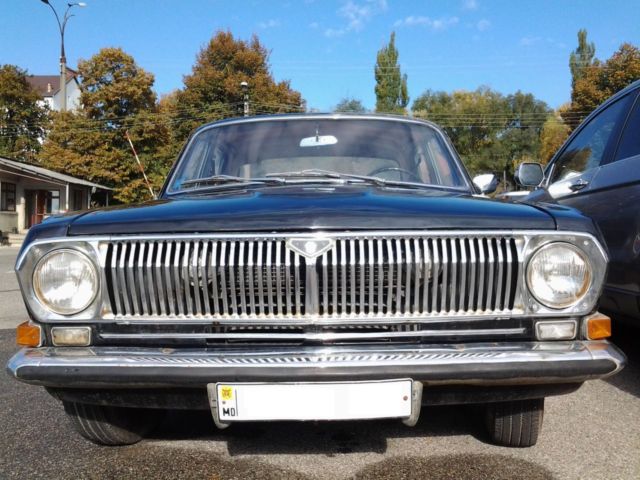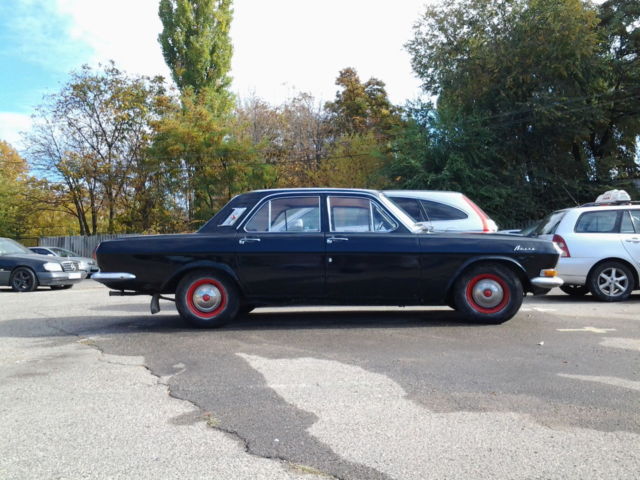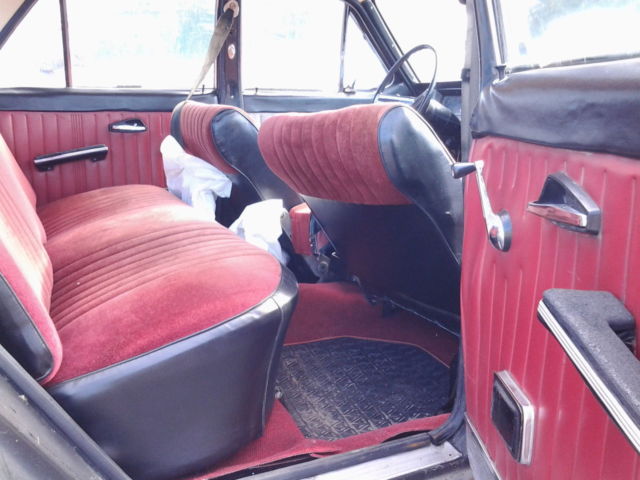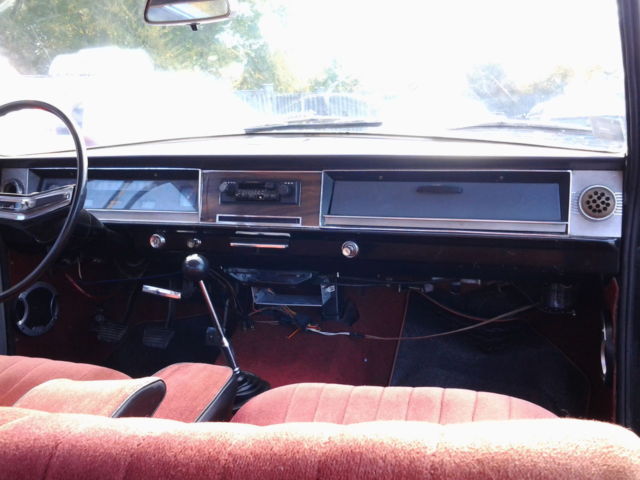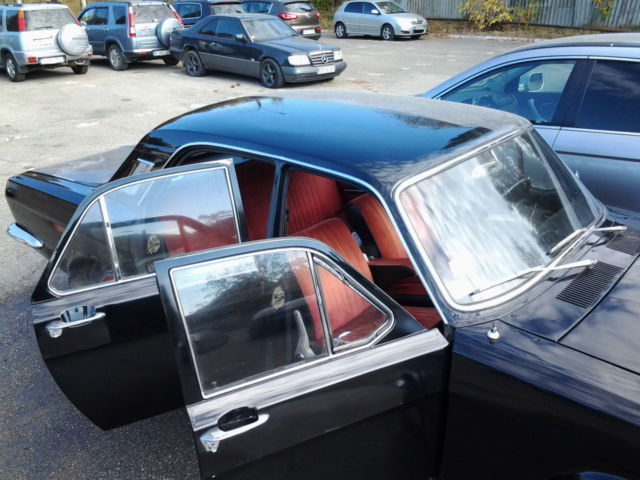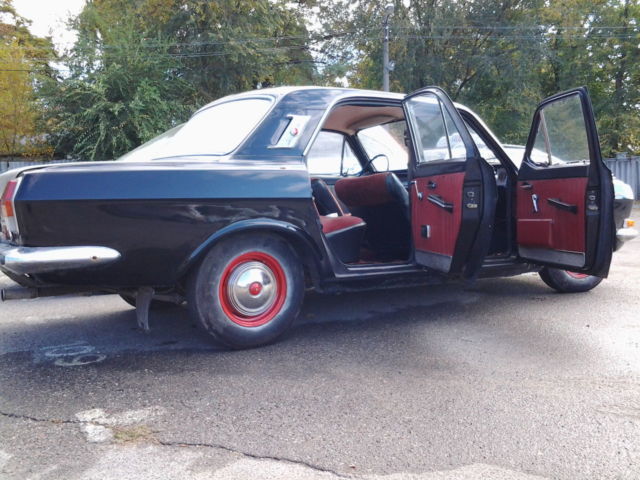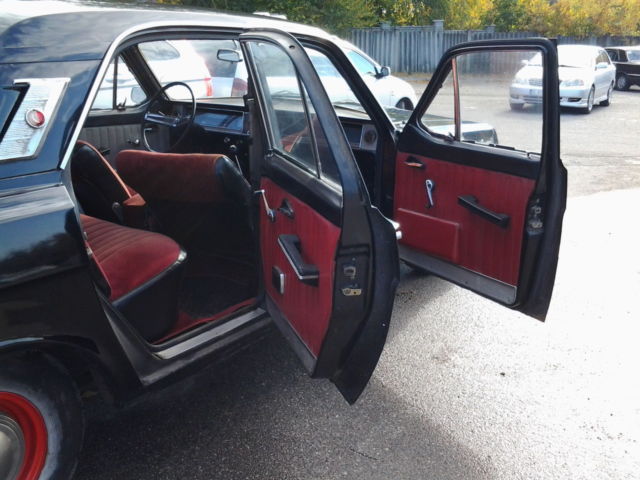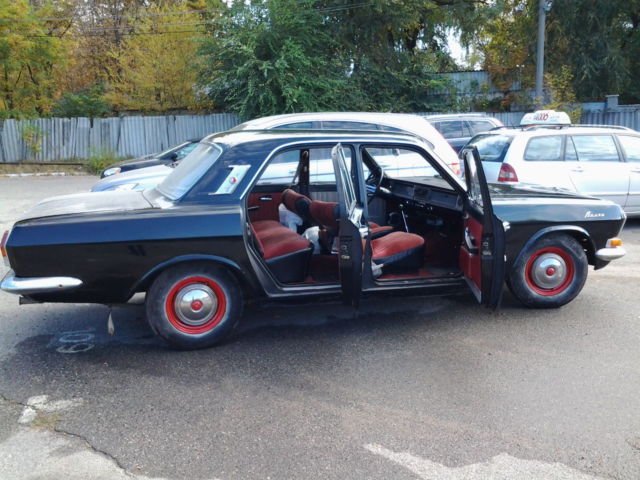GAZ 2410 Volga 1973
- Condition: Used
- Make: Other Makes
- SubModel: 2410
- Type: Sedan
- Year: 1973
- Mileage: 150,000
- Color: черный
- Fuel: Gasoline
- Transmission: Manual
- Interior color: Red
- Options: Cassette Player
- Vehicle Title: Clear
- Interested?
1973 Other Makes 2410 Description
GAZ 2410 Volga 1973All questions please contact me
Design of GAZ-21's replacement began in early 1960s, and original sketches showed an evolution from the contoured body of the early 1960s to the more angular and rigid profile. The M24 was to introduce the popular measureeconomy of scaleinto the model range, where the same body would house different powertrains, mechanics and interior trim, and hence could me marketed as separate cars (platform sharing). GAZ hoped to employ this on the new Volga and a range was drawn where the entry model would carry the traditional, though modernised, four cylinder engine and manual transmission (the prototype appeared with a 120hp(89kW; 120PS) 2,990cc (182cuin)V6).[43]The first prototypes were built in 1966, and a year later the car was certified for production. For economic reasons V6 model, despite showing promising results, was deemed infeasible for mass production. The first batch of 24 vehicles were assembled in 1968, 215 more followed in 1969 and in a public ceremony held on 15 July 1970 the car superseded the GAZ-21 on conveyor without halting it.
Like the GAZ-21 (and most Soviet-built cars), its exterior was inspired by US-models, essentially theChevy IIand its German stylistic derivativeOpel Rekord Aof the early '60s. Despite its more imposing appearance, the GAZ-24 was in fact 75mm (3.0in) shorter in length and 120mm in height, yet its wheelbase was extended by 10mm. The lower body waist line, allowed the window area was to be increased, whilst using thinner linings in doors, roof and other body panels, notably increased interior space. The combination of this progressive design and a lower clearance gave it a much more lighter and elegant aura.
The car was powered by a 2,445cc (149.2cuin)[44]ZMZ-24D engine, an evolution of the ZMZ-21A. Retaining the basic OHV configuration, it now ran on92 RONgasoline (while the ZMZ 24-01 could use commonly available 76 octane, and the 24-07 could useliquid propane).[45]Thecylinder blockwasdie cast, instead of the slowercoquillefor the 21A. The engine featured a twin-choke carburettor, with a higher compression ratio, producing 95hp(71kW; 96PS) at 4500 rpm and an even more impressive 186N·m(137ft·lbf) of torque at 2200–2400 RPM. Transmission was now fully synchronisedfour on floorlayout. The brakes were improved, with a hydraulic vacuumservounit (a licence-built Girling PowerStop), as well as an independent parking brake (rather than transmission brake of the GAZ-21). At the same time, certain features were retained for their proven reliability, like thekingpinfront suspension[46]andrecirculating ballsteering.
The car was built in several modifications and these were now indicated by numbers rather than letters. The sedan version was called GAZ-24. GAZ-24-01 was the taxi, which included a robustartificial leatherinterior and a slightly modified ZMZ-21A engine to run on 80 RON petrol. GAZ-24-02 was the estate wagon, introduced in 1972. Unlike the GAZ-22, it was serially assembled on a reserve conveyor, rather than out of sedan side panels. The rear, fifth, door was now a single unit that opened upwards instead of sideways. The car could seat eight people, due to a third row of seats in the cargo section. To allow maximum cargo volume and functionality, the seats in third and second rows were split (rather than a single bench) and could be folded independently of each other. GAZ-24-03 was the ambulance version of the -02. GAZ-24-04 was the taxi estate, with the powerplant and interior trim of the -01. In 1977 a GAZ-24-07 conversion kit was introduced for taxiparks. The GAZ-24-24 was the successor to the GAZ-23 "Chaser", with an identical V8 and automatic gearbox from the Chaika. Yet, unlike the -23, given the purpose of the car, even less effort was put in to differentiate it from standard vehicle due to costs. For example the automatic selector was masked under a standard shifting lever. A small batch of export cars for countries with left-hand traffic was called GAZ-24-54 (less than a thousand examples built[citation needed]). GAZ-24-76 and -77 were export versions toBeneluxcountries, who would retrofit the cars with Indénor diesels and a more luxurious trim such asvinyl roof. Five experimental vehicles were built on the chassis ofGAZ-694×4, called GAZ-24-95, one of which was known to be personally used byLeonid Brezhnev.
Though the vehicle never underwent a generational facelift on the scale of the GAZ-21 (if one does not count its derivative successors), nonetheless the car was modernised during production. The early stage included removal of bonnet-mounted rear-view mirrors, new ignition and boot locks. The novel belt-speedometer proved too complicated and was replaced by a standard arrow-driven one, as was the fate of the engine cooling coupling that controlled the ventilator fan (proved unreliable, the ventilator would be permanently on, whilst warm air for cold starts would be manually controlled with venetian-type shutter). Additions included external comfort lights were on the rear pillar's chrome element, that turned on upon opening of rear doors.
In the original design brief the GAZ-24 was to be retired by 1978, and though by that time work on a successor (theGAZ-3102) was underway, it was clear that the car would have to soldier on the conveyor for a foreseeable future. In 1977, following a 1976 report by NAMI on the Volga's major shortcomings (problematic steering prime among them), GAZ refused to update the GAZ-24's front suspension, instead making only cosmetic changes.[47](The front suspension would be unchanged until 2003, when thekingpinswere changed to sealedball joints,[48]while the rear got anantiroll bar.[49]) Visually, these Volgas can be identified by front and rear bumper overriders, front fog lights and rear reflectors integrated into a single block. Inside the car gained retractable seat belts, a new dashboard where all exposed metal elements were covered by plastic. In this final shape the car was produced until 1986, the estate until 1987. Including the GAZ-24-10, almost one and a half million such Volgas were produced.
Overall, the original Model 24 Volga was a major success. Like the GAZ-21, it remained a dream car for the Soviet consumer. However, unlike the GAZ-21 it cost almost twice as much, and given that its launch coincided with the launch of theVAZplant, the more available Lada allowed for the Volga to rise in exclusivity. The lion's share of cars were used for the ever-growing Sovietnomenklaturaand the rest in taxi, police and ambulances. Private ownership would often be offered only to representatives of Soviet elite and celebrities. Given that it was possible to openly purchase a new Volga only viaBeryozkachain (where it cost almost ten thousand rubles) its resale value would thus be several times higher than the stated nominal price. In both cases, the sum would be well outside the financial abilities of theSoviet working class. Thus, though the car was as iconic of its time as the predecessor, it was also become a symbolic feature ofSocial stratificationin the USSR, and theEra of Stagnationduring which it was produced. This more negative connotation began to disperse following the introduction of the GAZ-3102.
Whereas the GAZ-21 became a collectible by the Soviet Union's collapse, the GAZ-24 extended assembly line life meant that only in the late 2000s have prices for low-mileage mint-condition models and restoration interest began to climb.
GAZ always desired a six-cylinder version, and built prototypes with a variety of sixes: a 125hp(93kW; 127PS) 2,494cc (152.2cuin)BMWin 1973, a 120hp(89kW; 120PS)Peugeot(as used in thePeugeot 604andVolvo 260) in 1978, aMercedes R6in 1975, and a 135hp(101kW; 137PS) (the2.8from aFord Scorpio) in 1984.[50](The 2,445cc (149.2cuin) continued in production until 2008, by then only on special order.)[51]
In 1977, the 31011, with the 160hp(120kW; 160PS) 4,250cc (259cuin) V8 and automatic transmission, appeared, for KGB and police use, joined by the experimental 31014 with 5,530cc (337cuin) ZMZ 503.10 V8, delivering 195hp(145kW; 198PS) and 450ft·lbf(610N·m).[52]Production pursuit cars, which became available in 1986, were 31012s with the 5.5 liter (with one four-choke carburetor), fitted with a three-speed automatic and power steering (some with power windows and air conditioning), while the 31013 was the same, but withelectronic ignition.[53]These "were quite simply the fastest cars on Russian roads",[54]and they got just 20 litres per 100 kilometres (14mpg-imp; 12mpg-US).[55]Their low-key appearance made themsleepers, though Soviet and Russian drivers soon learned to spot the extra radio aerials and dual exhausts.[56]These cars were never true production models, "to all intents and purposes hand built".[57]How many were made is unknown, the last being assembled in 1995.[58]
Small numbers were built with the 140hp(100kW; 140PS) two-rotor 1,300cc (80cuin)VAZ-411-01Wankel engine(which featured a 9.4:1compression ratio) as the 31028.[59]It was never common.[60]There are reportedly also a few with the three-rotorVAZ 431rotary, and with a pair of single-rotors operated independently[61](a bit like anArmstrong Siddeley Double Mamba). The rotary models were operated by KGB and traffic police, but these agencies preferred V8-powered 3102s.[62]
There was also a prototype 31015 built in 1989, with a 160hp(120kW; 160PS) 2,600cc (159cuin) Mercedes engine.[63]
The GAZ-24 was the Eastern Bloc's largest family car, but proved difficult for families to actually obtain, with official purchases at first taking precedence.[64]
 GAZ 2410 Volga
GAZ 2410 Volga
Mileage: 66,000
 1960 1960 2nd series Other brands: Volga GAZ-21 Volga GAZ-21 1960 of a series 2n
1960 1960 2nd series Other brands: Volga GAZ-21 Volga GAZ-21 1960 of a series 2n
Mileage: 5,000
 Volga
Volga
Mileage: 1
 Volga Gaz 24
Volga Gaz 24
Mileage: 85,000
 GAZ 24 Volga
GAZ 24 Volga
Mileage: 46,000
 GAZ 21 Volga export
GAZ 21 Volga export
Mileage: 11,460
 1980 GAZ-24 VOLGA 24
1980 GAZ-24 VOLGA 24
Mileage: 75
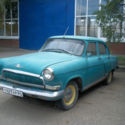 VOLGA ГАЗ-21 «Волга» СССР
VOLGA ГАЗ-21 «Волга» СССР
Mileage: 90,133
 GAZ-24 Volga 1986 Renovated
GAZ-24 Volga 1986 Renovated
Mileage: 88,635
 Volga M-21 russian oldtimer car
Volga M-21 russian oldtimer car
Mileage: 42,000
